1997 CHEVROLET S10 tire pressure
[x] Cancel search: tire pressurePage 145 of 402
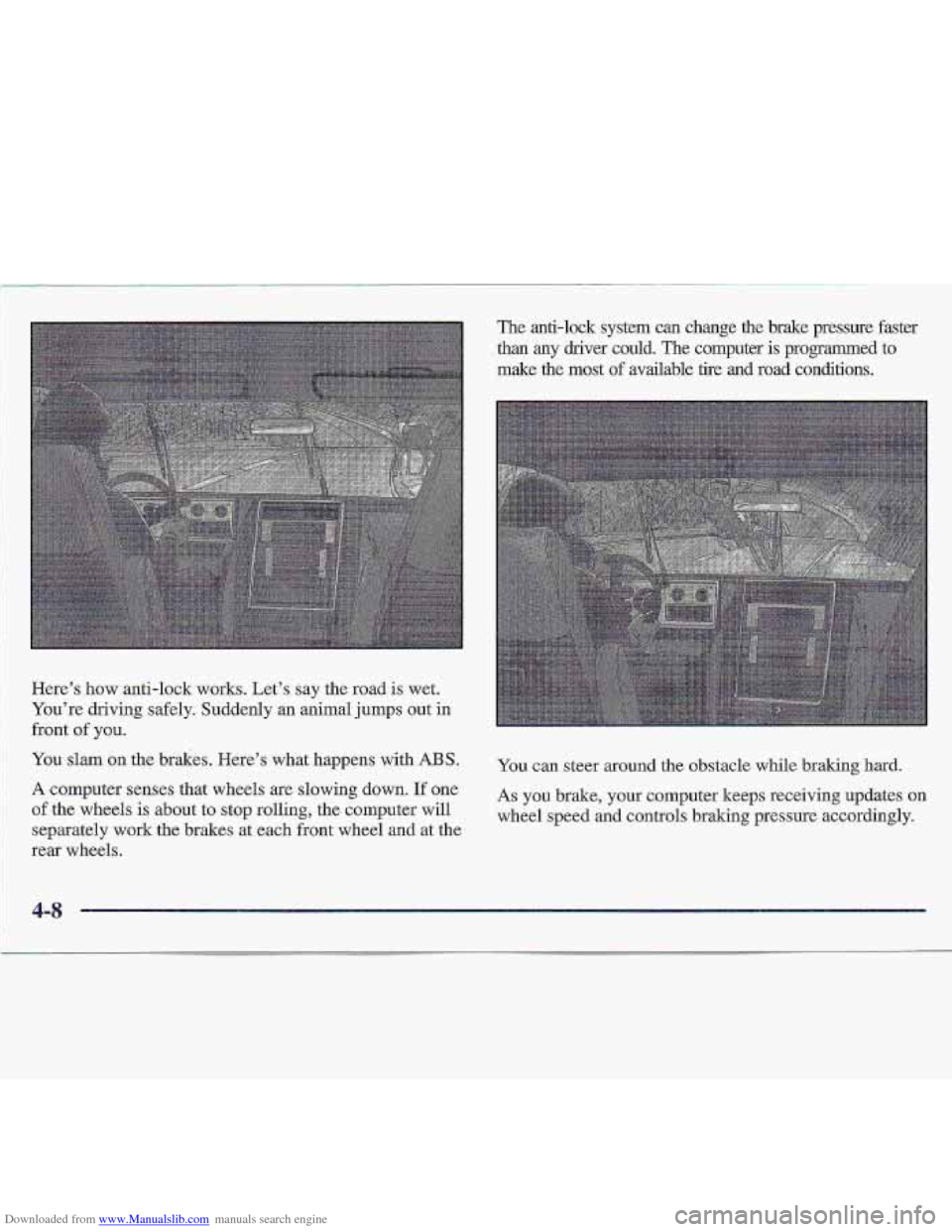
Downloaded from www.Manualslib.com manuals search engine Here’s how anti-lock works. Let’s. say the road is wet.
You’re driving safely; Suddenly-an animal jumps out
in
front of you.
1 You slam on the brakes, Here’s what happens with ABS.
A computer senses that wheels are slowing down. If one
of the wheels is about to stop rolling, the computer will
separately work the brakes at each front wheel and at the
~ rear wheels.
The anti-lock system em change the brake p~essure faster
than any driver could. ?%e computer is programmed to
make the most of available tire and road tronditions.
You cansteer around the obstacle while braking hard.
As you brake, your computer keeps receiving updates- on
wheel speed and controls braking pressure accordingly.
Page 164 of 402
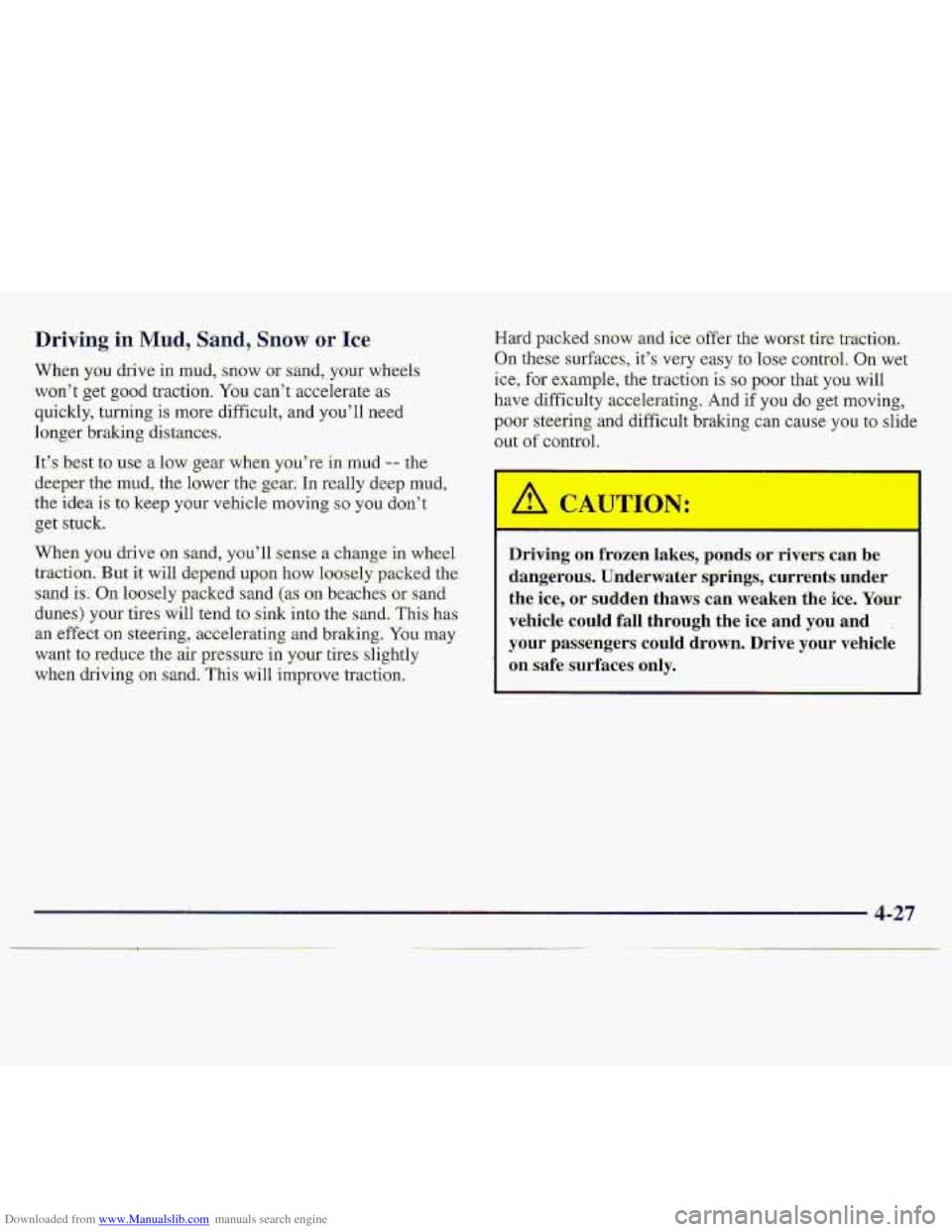
Downloaded from www.Manualslib.com manuals search engine Driving in Mnd, Sand, Snow or Ice
When you dxive in mu.d, snow or sarsd, your wheels
won’t get good traction. You can’t accelemte as
quickly, turning i.s more dif€icult, and you’ll need
longer braking distances.
It’s best .to use a low..gear when you’re in mud -- the
,deeper the mud, the lower the gear: In really ,deep mud,
$he idea is to keep your vehicle- moving s.0 you don’t
.!get stuck.
When
you drive on sand, yo-u’ll sensg a change- in wheel
traction, But St will &pmd upon how looseiypacked the
,sand is. On loosely packed sand (as on. beaches or sand
dunes)
your tires will tend to sink into the sand. This has
an effect on steering, accelefating and braking. You may
,w.ant to reduce the air pressure in your tires slightly
when driving on :sand. ‘This. will improve traction,
Hard packed mow ;sad ice. oEer the wofWtire’tractioa.
On thes~e s-Urfac.e.s, it’s very easy to lase c.on!Td, On wet
ice, for example, the traction i.s so paor that you will
h,ave diffic-ulty
accelerating, And if you d:o gkt movi.ng,
poor sleeting and difficult braking- can cause you to slide
out of control.
Driving on frozen lakes, ponds or rivers can be
dangerom. Undewater sprirmgs, currents under
the ice, or
sudden thaws can weaken the ice, Your
vehicle could fall through the ice and you and ,
your passengers could drown. Drive your vehicle
on -safe-surfaces only.
Page 181 of 402
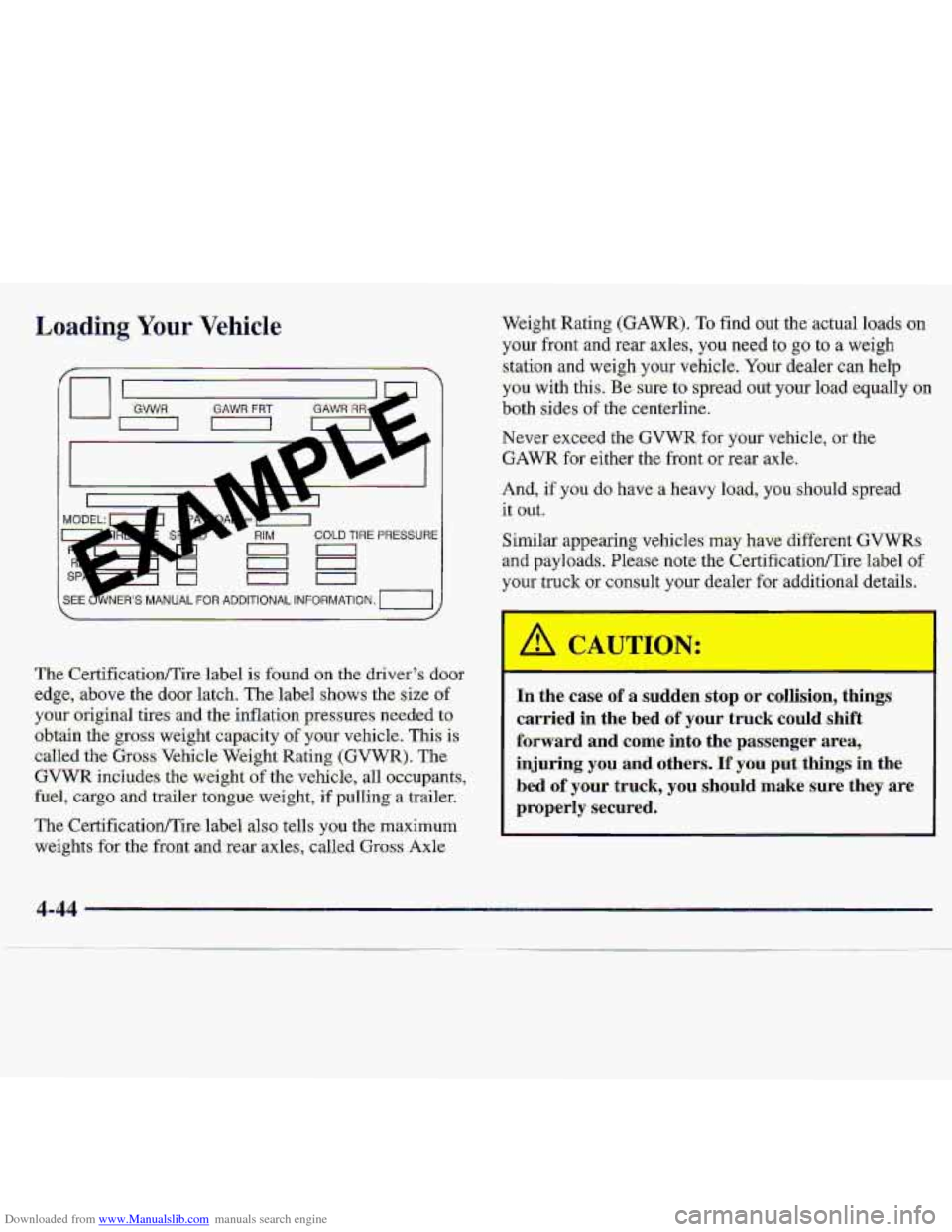
Downloaded from www.Manualslib.com manuals search engine Load& Your Vehicle
The Certification/Tire.iabel is found on the driver's door
edge, -above the door latch. The label shows the size of
your original. tires and the inflation pressures needed to
obtain the grass weight capacity of your vehicle. This is
called
the Gro-ss- Vehicle Weight Rating (GVWR). The
GVWR
includes the weight of the vehicle, all occupants,
fuel,
cargo aild trailer tongue weight, if pulling a-trailer.
The C&tification/Tire. label
also tells you the maximum
weights for the front and-re,ar axl.es, called Grass Axle Weight
.Rating (GAWR).
To find Qut the actual loads on
your front and rear axles, you need to go to a we.igh
station and weigh your-vehicle. Your dealer
can help
you with this. Be sure to spread out your load equally on
bath sides of the centerline..
Never exceed the GVWR for your vehicle, or the
GAWR
hi either the front or rear axle.
And, if you do have a heavy load, you- sho,uld spfead.
it
out.
Similar appearing vehicles. may have. differeQt GVWRs
and payloads. Please note the Certificatioflire. label sf
your truck or consult your dealer for additional details.
In the.case of a gudden stop or collision, things
carried in the bed of your truck could shift^
forward and come into the passenger area,
injuring you and others. 'If you put things in the
bed of your truck, you should rnake.su.re they are
properly
secured.
I
Page 232 of 402

Downloaded from www.Manualslib.com manuals search engine A, Hub Cap Removal Tool (Some Mmiels)
E. Cover (Extended Cab)
%. Cover (Stand,ard Cab)
D. Hub Cap Removal Tool (Some Models)
E. Bdt
Compact Spare Tire (If Equippe.d)
Although the compact spare-tire was fully inflated when
your vehicle w.as new, it can lose air after a time. Check
the. inflation pressure regularly. It should be 60 psi
(420 kPa).
After installing the compact spare on your vehicle, you
should stop as 'soon as possible and 'm.ake-. sure your
spare tire
is cor-rec.tly inflated. The compact spare is
made to perform well at speeds up to 65 :mph
(I 05 krn/h) for distances up to 3,000 miles (5.000 km),
so you can finish your trip and have your full-size tire
repaired or replaceid where.you
want. Of course, it's best
to replace y0.w spare with a full-size tire as soon as you
can. Your spare will last longer and be: in .good shape in
case you-need it again.
I NOTICE: I
When the compact 'spare: is installed, don't ta.ke
your vehicle through
an automatic car wash with
guide rails, The compact spare can get caught on
the rails; That can damage the tire and wheel,
-and maybe other-parts of your vehicle.
Page 281 of 402
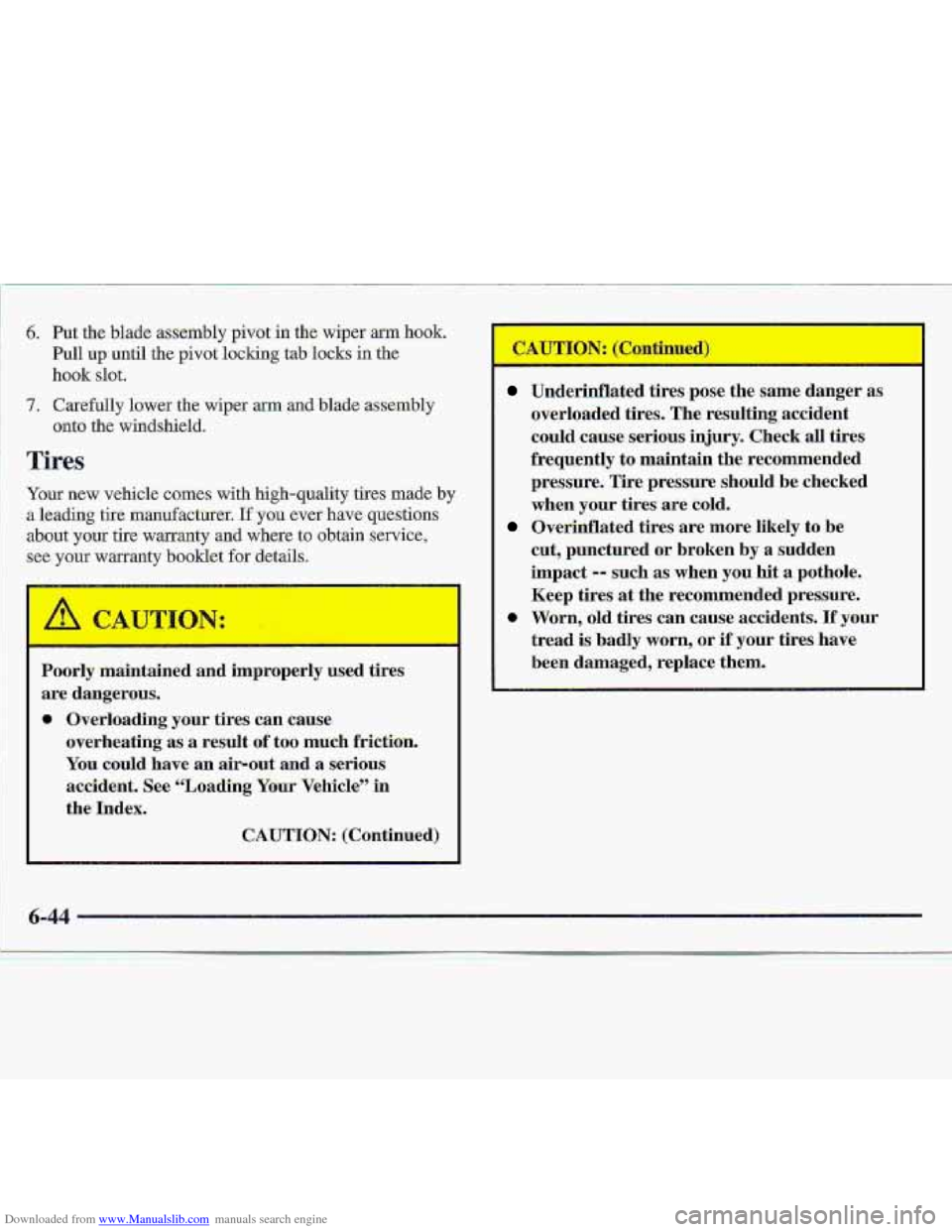
Downloaded from www.Manualslib.com manuals search engine 1 F
Poorly maintained and improp-erly used tires
are dangerous.
0 Overloading your tires can cause
overheating as a result
of too much, friction.
You could have an air-out and a serious
accident. See “Loading Your Vehicle” in
the Index.
CAUTION: (Continued)
Unaerinflated tires pose the same danger as
overloaded tires. The resulting-accident
could cause serious injury. Check all tires
frequently to maintain the recommended
pressure. Tire pressure should be checked
when your tires are cold.
cut, punctured
or broken by a sudden
impact
-- such as when you hit a pothole.
Keep tires at the recommended pressure.
0 Worn, old tires can cause accidents. If your
tread
is badly worn, or if your tires have
been damaged, replace them.
Overinflated tires are more likely to-be
6-44
Page 282 of 402
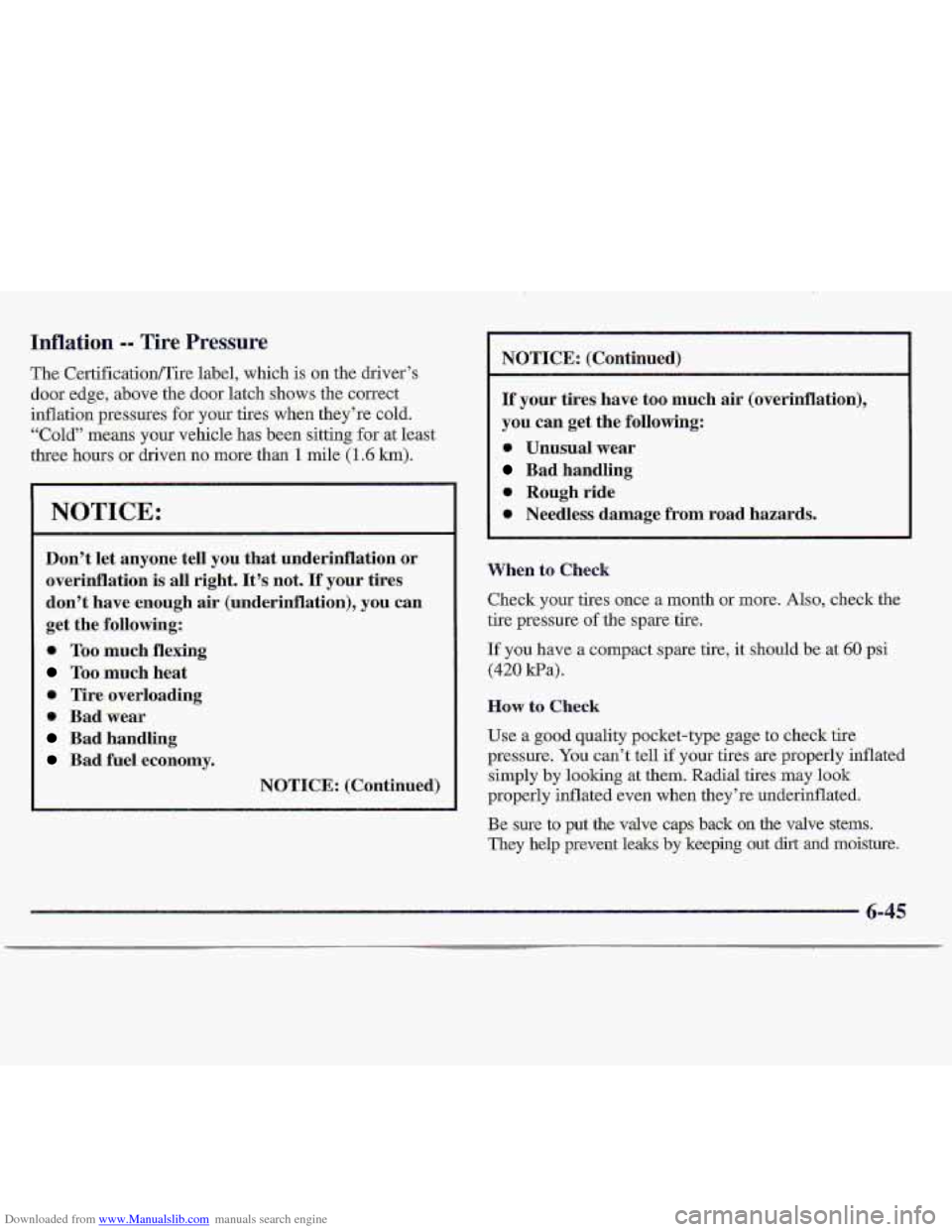
Downloaded from www.Manualslib.com manuals search engine Inflation -- Tire Pressure
The CertificationlTire label, which is on the driver’s
door edge, .above .the door latch shows the correct
inflation pressures for your
tires when they’re cold.
“Cold” means your vehicle has been sitting
for at least
three hours
or driven no more than 1 mile (1.6 km).
NOTICE:
Don’t let anyone tell you that underinflation or
overinflation is all right. It’s not. If your tires
don’t
have enough air (underinflation), you can
get
the following:
Too much flexing
Toa much heat
@ Tire overloading
0 Bad wear
Bad handling
Bad fuel economy.
NOTICE: (Continued)
NOTICE: (Continued)
If your tires have too much air (overinflation),
you can get the following:
9 Unusual wear
Bad handhg
0 Rough ride
1) Needless damage from road hazards.
When to Check
Check your tires once a month or more. Also, check the
tire pressure
of the spare tire.
If you have a compact
spare tire, it should be at 60 psi
(420 kPa).
How to Check
Use a good quality pocket-type gage to check tire
pressure.
You can’t tell if your tires are properly inflated
simply by looking at them. Radial tires may
look
properly inflated even when they’re underinflated,
Be sure to put the valve caps back on the valve stems.
They help prevent leaks by keeping out dirt and moisture.
6-45
Page 283 of 402
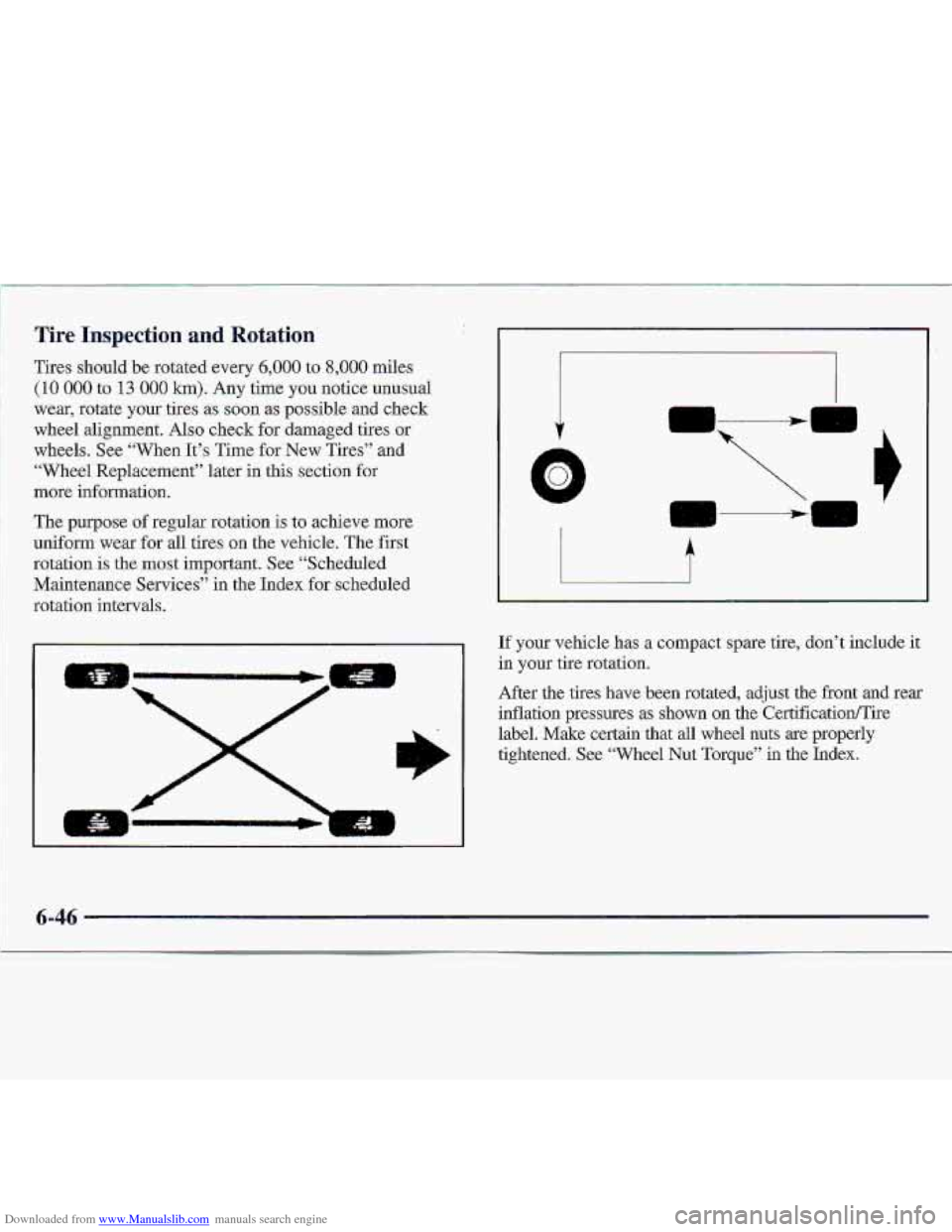
Downloaded from www.Manualslib.com manuals search engine Tire Inspection and Rotation
Tires should be rotated every 6,000 to 8,000 miles
(10 QOO. to 13 0.00 km). Any time you notice unusual
wear, rotate your tires
as soon as possible and check
wheel alignment. Also check for damaged tires or
wheels. See “When
It’s Time for New Tires” and
“Wheel Replacement” later in this section for
more information.
The purpose
of regular rotation. is to achieve more
uniform wear for
all tires on the vehicle. The first
rotation is the mast important. See “Scheduled
Maintenance Services”
in the Index for scheduled
rotation intervals.
If your vehicle has a compact spare tire, don’t include it
in your tire rotation.
After the tires have bea rotated, adjust the front
and rear
inflation. pressures
as shown on the Certificatioflire
label. Make certain that all wheel nuts
are. properly
tightened. See “Wheel Nut Torque” in the Index.
6-46 ,,,. .. -~I
Page 398 of 402
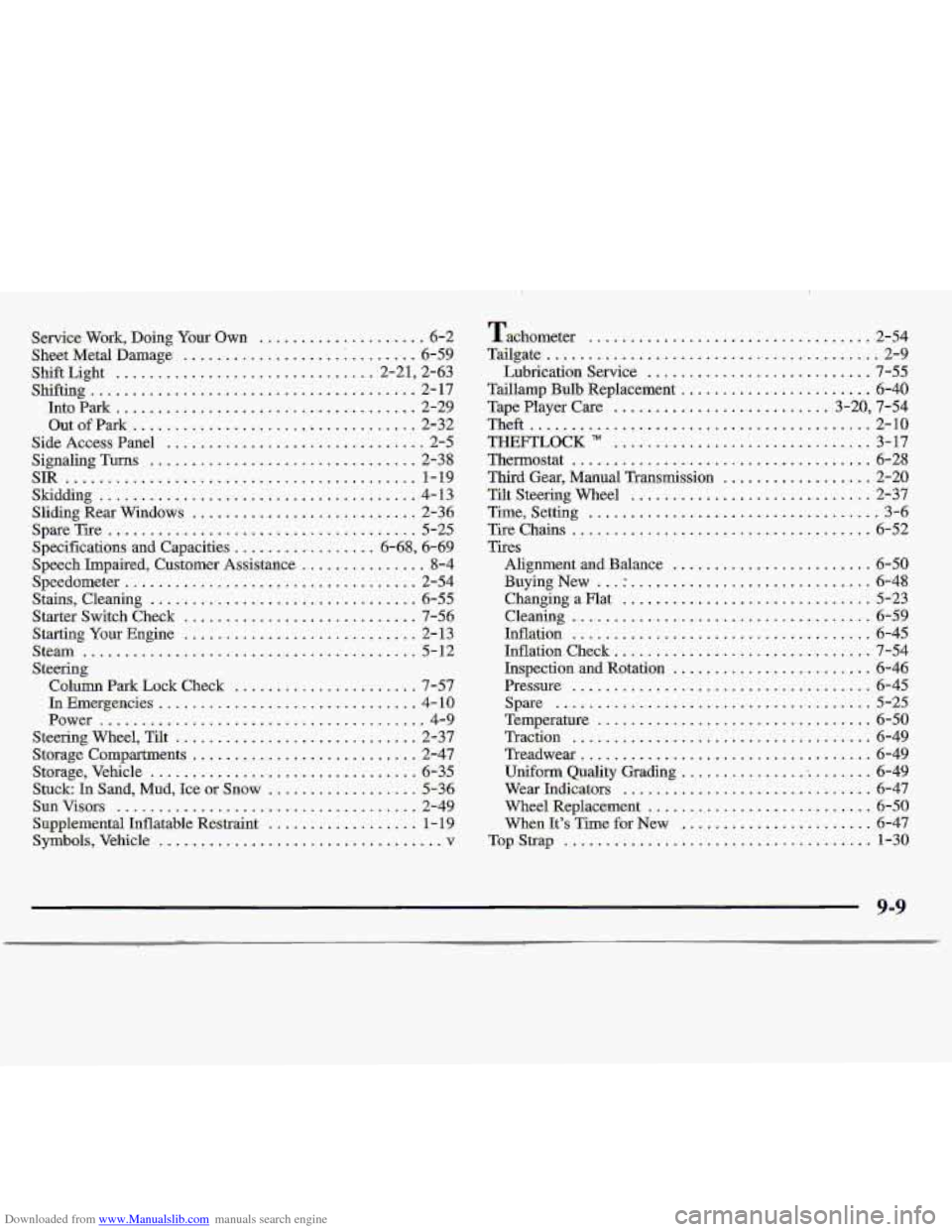
Downloaded from www.Manualslib.com manuals search engine Service Work. Doing Your Own .................... 6-2
SheetMetaJDamage
................... i........ 6-59
Shift Light
............................... 2-21’2-63
Shifting
....................................... 2-17
IntoPark .................................... 2-29
Out of Park .................................. 2-32
Side Access Panel
............................... 2-5
Signaling Turns
................................ 2-38 .
SIR .......................................... 1-19
Skidding ...................................... 4-13
Sliding Rear Windows ........................... 2-36
SpareTire ..................................... 5-25
Specifications and Capacities
.................. 6-68, 6-69
Speech Impaired, Customer Assistance
............... 8-4
Stains, Cleaning ................................ 6-55
Starter Switch Check
............................ 7-56
Starting Your Engine
............................ 2- I3
Steam
........................................ 5-12
Steering Speedometer
................................... 2-54
Colizi~~~ Pirk Lock Check
...................... 7-57
In Emergencies ............................... 4- 10
Power ....................................... 4-9
Steering Wheel, Tilt ............................. 2-37
Storage Compartments
........................... 2-47
Storage,.Vehicle
................................ 6-35
Stuck: In Sand,
Mud, Ice or Snow .................. 5-36
SunVisors .................................... 2-49
Supplemental Inflatable Restraint
.................. 1 - 19
Symbols, Vehicle .................................. v
Tachometer .................................. 2-54
Tailgate
........................................ 2-9
Lubrication Service
........................... 7-55
Taillamp
Bulb Replacement ....................... 6-40
Tape Player Care .......................... 3.20. 7.54
Theft
......................................... 2-10
Thermostat
.................................... 6-28
Third Gear.
Manual Transmission .................. 2-20
Tilt Steering Wheel ............................. 2-37
Time. Setting
................................... 3-6
Tire Chains ................................... -5-52
Tires Alignment and Balance
......................... 6-50
Buying
New ... : ............................. 6-48
ChangingaFlat
.............................. 5-23
Cleaning
.................................... 6-59
Inflation
.................................... 6-45
Inflation Check
............................... 7-54
Inspection
and Rotation ........................ 6-46
Pressure
.................................... 6-45
Spare
...................................... 5-25
Temperatme ................................. 6-50
Traction .................................... 6-49
Treadwear
..................................... 6-49
Uniform Quality Grading
........................ 6-49
Wear Indicators
.............................. 6-47
Wheel Replacement ........................... 6-50
When It’s Time for New ....................... 6-47
Topstrap
..................................... 1-30
THEFTLOCK TM ............................... 3-17
9-9